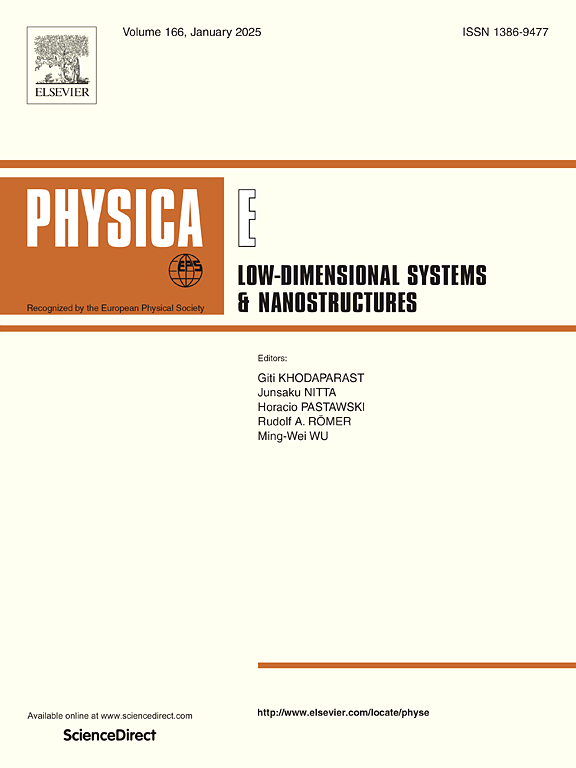Design of spintronic devices based on adjustable half-metallicity induced by electric field in A-type antiferromagnetic bilayer NiI2
IF 2.9
3区 物理与天体物理
Q3 NANOSCIENCE & NANOTECHNOLOGY
Physica E-low-dimensional Systems & Nanostructures
Pub Date : 2024-10-10
DOI:10.1016/j.physe.2024.116129
引用次数: 0
Abstract
Exploring the attainment of half-metallic behavior in two-dimensional (2D) materials through external perturbations is a popular area of current research. In this work, we demonstrate, using first-principles calculations, that bilayer NiI2 (bi-NiI2) is an A-type antiferromagnetic (AFM) semiconductor with an indirect bandgap of 0.86 eV, with the most stable configuration being the AB stacking mode. Upon the application of a vertical electric field, the material transforms from its original semiconducting state into a half-metallic state. Moreover, the spin polarization reverses its orientation whenever the direction of the electric field is altered. This intriguing behavior has inspired us to design a spintronic device based on the A-type AFM bi-NiI2. By employing nonequilibrium Green's function (NEGF) combined with density functional theory (DFT) calculations, we find that the device achieves ON/OFF switching by applying vertical electric fields in parallel or anti-parallel configurations in the two leads. The device displays 100 % spin polarization in the parallel configuration (PC) scenario, driven by bias voltage or temperature differences. Utilizing either the parallel or antiparallel configuration (APC) for ON/OFF switching enables the device to exhibit tunneling magnetoresistance (TMR) of up to 1.45 × 1010 % due to bias voltage and up to 1011 % thermal TMR arising from temperature differences between the leads. These findings highlight the potential of NiI2 and A-type AFM bilayers in the design of spintronic devices.
基于 A 型反铁磁双层 NiI2 中电场诱导的可调半金属性设计自旋电子器件
探索通过外部扰动在二维(2D)材料中实现半金属行为是当前研究的一个热门领域。在这项研究中,我们利用第一原理计算证明,双层 NiI2(bi-NiI2)是一种 A 型反铁磁性(AFM)半导体,其间接带隙为 0.86 eV,最稳定的构型是 AB 堆积模式。当施加垂直电场时,这种材料会从原来的半导体状态转变为半金属状态。此外,只要改变电场方向,自旋极化就会反转方向。这一引人入胜的行为启发我们设计一种基于 A 型 AFM 双 NiI2 的自旋电子器件。通过采用非平衡格林函数(NEGF)和密度泛函理论(DFT)计算,我们发现该器件可以通过在两条引线上施加平行或反平行配置的垂直电场来实现导通/关断开关。在平行配置(PC)情况下,该器件在偏置电压或温差的驱动下显示出 100% 的自旋极化。利用平行或反平行配置(APC)进行导通/关断开关,可使器件因偏置电压而表现出高达 1.45 × 1010 % 的隧穿磁阻(TMR),因引线之间的温差而表现出高达 1011 % 的热 TMR。这些发现凸显了 NiI2 和 A 型 AFM 双层膜在设计自旋电子器件方面的潜力。
本文章由计算机程序翻译,如有差异,请以英文原文为准。
求助全文
约1分钟内获得全文
求助全文
来源期刊
CiteScore
7.30
自引率
6.10%
发文量
356
审稿时长
65 days
期刊介绍:
Physica E: Low-dimensional systems and nanostructures contains papers and invited review articles on the fundamental and applied aspects of physics in low-dimensional electron systems, in semiconductor heterostructures, oxide interfaces, quantum wells and superlattices, quantum wires and dots, novel quantum states of matter such as topological insulators, and Weyl semimetals.
Both theoretical and experimental contributions are invited. Topics suitable for publication in this journal include spin related phenomena, optical and transport properties, many-body effects, integer and fractional quantum Hall effects, quantum spin Hall effect, single electron effects and devices, Majorana fermions, and other novel phenomena.
Keywords:
• topological insulators/superconductors, majorana fermions, Wyel semimetals;
• quantum and neuromorphic computing/quantum information physics and devices based on low dimensional systems;
• layered superconductivity, low dimensional systems with superconducting proximity effect;
• 2D materials such as transition metal dichalcogenides;
• oxide heterostructures including ZnO, SrTiO3 etc;
• carbon nanostructures (graphene, carbon nanotubes, diamond NV center, etc.)
• quantum wells and superlattices;
• quantum Hall effect, quantum spin Hall effect, quantum anomalous Hall effect;
• optical- and phonons-related phenomena;
• magnetic-semiconductor structures;
• charge/spin-, magnon-, skyrmion-, Cooper pair- and majorana fermion- transport and tunneling;
• ultra-fast nonlinear optical phenomena;
• novel devices and applications (such as high performance sensor, solar cell, etc);
• novel growth and fabrication techniques for nanostructures

 求助内容:
求助内容: 应助结果提醒方式:
应助结果提醒方式:


